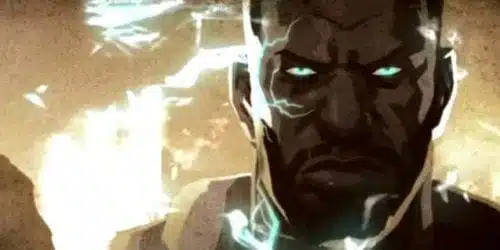
My wife’s reaction to Starhawk illustrates its biggest strength. She first saw the game during one of the aerial dog fighting sequences and commented on the dizzying maneuvers involved. The next time that she saw me playing, I was on foot, sniping at enemies while constructing large defensive buildings on the fly. “Is this the same game?” she asked. I confirmed that it was in fact the same game and gleefully proved it by quickly calling for a launch pad, jumping into a newly built jet, and blasting into the sky without so much as a frame rate hiccup.
Starhawk is a third-person shooter, a vehicle combat game, and a real-time strategy game rolled into one explosive package. You have direct control of a single character but also have the ability to cash in expendable energy to build structures and call for weapons. Supplies range from defensive walls and ammunition to the aforementioned jets, and they all strike the surface with a deadly impact that can make even a defensive move deadly for your enemies. Multi-level bases and enormous turrets pop up from the supply crates like Transformers. Parts spring up and frantically arrange and shift into place as the dust settles. It’s an immensely satisfying feeling and a very slick effect, one that represents the core of what Starhawk does right: dynamic, large-scale combat that seamlessly integrates a variety of tactics.
This core strength does much to bolster the game’s shortcomings. Starhawk suffers from a lack of what Nels Anderson calls “readability”, or the information that “players need to understand all the inputs and all the outputs to make interesting, informed decisions.” Unwelcome ambiguity and a lack of contextual information hampers everything from Starhawk’s interface to its story in small, yet meaningful ways.
For example, the machine gun’s targeting reticule changes from a neutral circle to a red X when firing at an enemy. It was probably an attempt to let people know that their shots were registering, but the combination of the red color (which I interpreted to mean as denoting successful shots) with the X (a symbol often used as a negative symbol) sends mixed messages. Similarly, you can transform your jet into a bipedal mech with the ability to stomp on ground troops. Each stomp is accompanied by a short, cinematic camera angle that shows a shockwave from the impact and the enemies crushed in the attack. Unfortunately, it’s unclear how much of this is flash and how much is substance, as I found out the hard way that neither the shockwave, nor my mech’s foot seemed able to destroy supply barrels that hold the energy needed to create more structures. This in turn undermined my understanding of how the attack affected enemies. If this attack can’t crush a barrel, then how effective is this on enemies?
Starhawk’s single player mode seems designed to gradually introduce all the structures that you can build as well as the various tactics that will come in handy during multiplayer matches. However, even after finishing it, very basic questions remained. What are the advantages and drawbacks of “basic,” “arcade,” and “pro” flight controls? What does a “powerslide” mean in the context of a flight game, rather than in that of a driving game? What is the point of upgrading a beam turret to a flak turret? Why do buildings have health bars but vehicles do not? Diegetic health indications like fire and sparks are nice, but it’s quite hard to see smoke against the blackness of space. All these things and more can be learned via trial and error, but it would have been nice to have some more formal training or reference source in the game.
Perhaps this explains the single player campaign’s forgiving difficulty. I played on normal, the setting explicitly labeled as “the way it was meant to be played” and rarely found myself pressured to cut my construction projects short. In the absence of challenging scenarios, I found myself paying closer attention to the game’s plot.
Starhawk’s sci-fi/Western milieu is charming, if ultimately a bit shallow. The juxtaposition between dusty mining towns and hi-tech weaponry is interesting, and fighting against a musical backdrop of Morricone-inspired guitar twangs and bells makes shootouts exhilarating. Unfortunately, the plot stops short of exploring the deeper themes found in many Westerns. Starhawk is unique in that it has both a black protagonist and antagonist, it revolves around resource exploitation, and it resembles the racialized conflict between Native Americans and U.S. expansionists. Despite all of this, the story never goes beyond a simple “bad guys vs. good guys” narrative.
Ultimately, all these issues aren’t enough to topple Starhawk’s fundamental accomplishment: its ability to accommodate massive, dynamic multiplayer combat scenarios. The word “visceral” is used so much in the video game world that it’s almost a joke, but it’s the best way I can describe how satisfying it is to watch a huge base crash down onto an enemy and then spawn a tank that lets three of your teammates turn the tide of battle and storm the enemy defenses.
It’s easy to get transfixed by the gloriously loud construction and destruction, but the key to victory requires both strategic thinking and quick thumbs. Darting into enemy territory to capture a flag while also depositing turrets in your wake takes a steady hand and plenty of coordination with support-minded teammates. Alternatively, you can turn your eyes skyward to see intense dog fighting and know that what seems to be a distant conflict is just one jet boost away.
It’s impressive to see a game that not only accommodates, but also that promotes so much variety, especially in the context of 16 vs. 16 multiplayer matches. It might take a while to completely grasp how all the aspects of Starhawk’s Wild West fit together, but once you do, it’s a treat.
